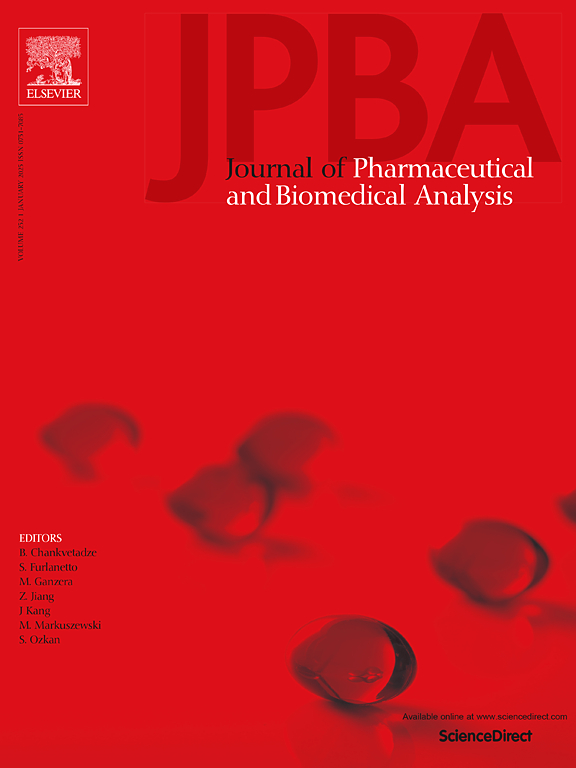Comprehensive characterization of the chemical composition of Ela tablet and its metabolites, with molecular docking screening of potential bioactive components for erectile dysfunction treatment
IF 3.1
3区 医学
Q2 CHEMISTRY, ANALYTICAL
Journal of pharmaceutical and biomedical analysis
Pub Date : 2025-02-26
DOI:10.1016/j.jpba.2025.116778
引用次数: 0
Abstract
Erectile dysfunction (ED) is a disorder involving both physiological and psychological implications, and phosphodiesterase 5 (PDE5) inhibitors serve as the primary treatment. The Ela tablet, a traditional herbal formulation, has demonstrated promising PDE5 inhibitory effects, yet its bioactive constituents and metabolic fate remain unclear. A four-step strategy combining offline two-dimensional supercritical fluid chromatography (SFC) and ultra-high-performance liquid chromatography coupled with high-resolution mass spectrometry (UHPLC-HRMS) was established to characterize the chemical composition of the Ela tablet. This was followed by in vivo metabolic profiling in rats to determine prototype compounds and metabolites. Molecular docking analysis was then conducted to evaluate the interaction of blood-absorbable prototype compounds with PDE5. A total of 362 compounds were identified, including flavonoids, alkaloids, terpenoids, organic acids and other classes of compounds. In vivo metabolic profiling revealed 70 compounds of prototype and metabolites, with hydrolysis and glucuronidation as the predominant metabolic pathway. Icaritin glycoside analogs underwent extensive metabolism producing Icaritin glucuronide conjugates as the major circulating forms, while N-alkylamides primarily remained in their prototype state. Molecular docking analysis revealed N-isobutyl-(2E,4E)-tetradecadienamide, Anacyclin, Dodeca-2E,4E-dienoic acid isobutylamide, Pellitorine, N-isobutyl-2–6–8-decatrienamide, Icaritin, and Desmethylicaritin as potential PDE5 inhibitors. These findings provide insights into the metabolic transformation and pharmacological mechanisms of the Ela tablet, supporting its potential clinical application in ED treatment. Future research should focus on pharmacokinetics, mechanistic validation, and clinical evaluation to further establish its therapeutic efficacy.
求助全文
约1分钟内获得全文
求助全文
来源期刊
CiteScore
6.70
自引率
5.90%
发文量
588
审稿时长
37 days
期刊介绍:
This journal is an international medium directed towards the needs of academic, clinical, government and industrial analysis by publishing original research reports and critical reviews on pharmaceutical and biomedical analysis. It covers the interdisciplinary aspects of analysis in the pharmaceutical, biomedical and clinical sciences, including developments in analytical methodology, instrumentation, computation and interpretation. Submissions on novel applications focusing on drug purity and stability studies, pharmacokinetics, therapeutic monitoring, metabolic profiling; drug-related aspects of analytical biochemistry and forensic toxicology; quality assurance in the pharmaceutical industry are also welcome.
Studies from areas of well established and poorly selective methods, such as UV-VIS spectrophotometry (including derivative and multi-wavelength measurements), basic electroanalytical (potentiometric, polarographic and voltammetric) methods, fluorimetry, flow-injection analysis, etc. are accepted for publication in exceptional cases only, if a unique and substantial advantage over presently known systems is demonstrated. The same applies to the assay of simple drug formulations by any kind of methods and the determination of drugs in biological samples based merely on spiked samples. Drug purity/stability studies should contain information on the structure elucidation of the impurities/degradants.

 求助内容:
求助内容: 应助结果提醒方式:
应助结果提醒方式:


